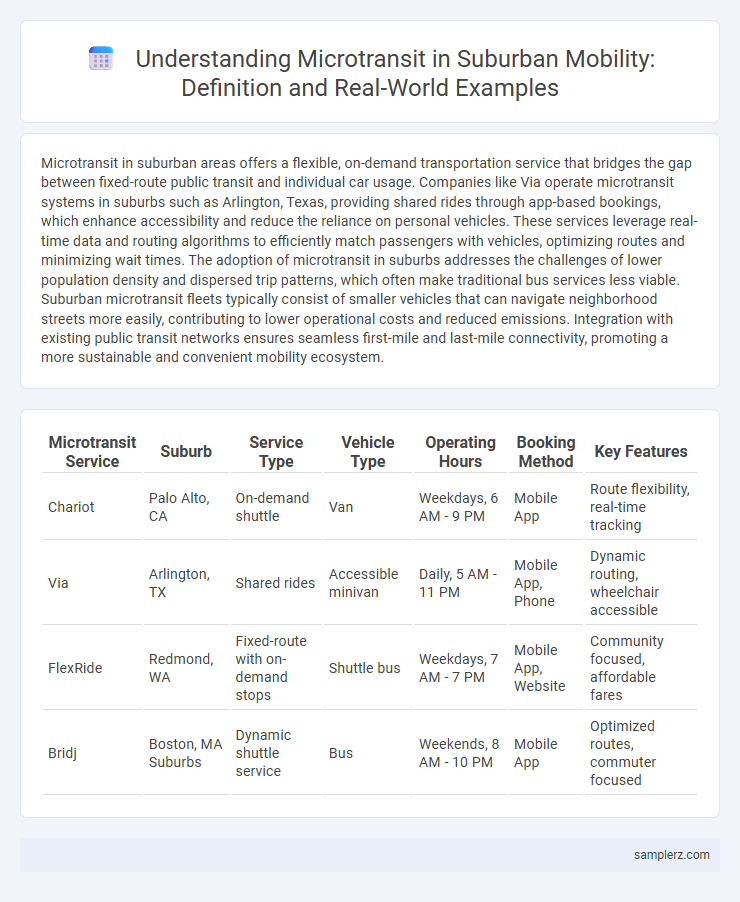Microtransit in suburban areas offers a flexible, on-demand transportation service that bridges the gap between fixed-route public transit and individual car usage. Companies like Via operate microtransit systems in suburbs such as Arlington, Texas, providing shared rides through app-based bookings, which enhance accessibility and reduce the reliance on personal vehicles. These services leverage real-time data and routing algorithms to efficiently match passengers with vehicles, optimizing routes and minimizing wait times. The adoption of microtransit in suburbs addresses the challenges of lower population density and dispersed trip patterns, which often make traditional bus services less viable. Suburban microtransit fleets typically consist of smaller vehicles that can navigate neighborhood streets more easily, contributing to lower operational costs and reduced emissions. Integration with existing public transit networks ensures seamless first-mile and last-mile connectivity, promoting a more sustainable and convenient mobility ecosystem.
Table of Comparison
| Microtransit Service | Suburb | Service Type | Vehicle Type | Operating Hours | Booking Method | Key Features |
|---|---|---|---|---|---|---|
| Chariot | Palo Alto, CA | On-demand shuttle | Van | Weekdays, 6 AM - 9 PM | Mobile App | Route flexibility, real-time tracking |
| Via | Arlington, TX | Shared rides | Accessible minivan | Daily, 5 AM - 11 PM | Mobile App, Phone | Dynamic routing, wheelchair accessible |
| FlexRide | Redmond, WA | Fixed-route with on-demand stops | Shuttle bus | Weekdays, 7 AM - 7 PM | Mobile App, Website | Community focused, affordable fares |
| Bridj | Boston, MA Suburbs | Dynamic shuttle service | Bus | Weekends, 8 AM - 10 PM | Mobile App | Optimized routes, commuter focused |
Introduction to Microtransit in Suburban Areas
Microtransit in suburban areas offers flexible, on-demand transportation services that bridge the gap between fixed-route transit and private vehicle use. This service typically operates with smaller vehicles and dynamic routing, catering to low-density populations where traditional public transit is less efficient. Incorporating microtransit solutions enhances mobility options, reduces reliance on cars, and supports sustainable transportation in suburban environments.
Key Benefits of Microtransit for Suburbs
Microtransit in suburban areas enhances connectivity by providing flexible, on-demand transportation tailored to lower-density populations, reducing reliance on personal vehicles and mitigating traffic congestion. It improves access to essential services and employment hubs, particularly benefiting non-drivers and those with limited mobility options. Cost-effective operation and scalable deployment enable suburban communities to efficiently expand transit coverage without the need for extensive fixed-route infrastructure.
Case Study: Via’s Microtransit Service in Arlington, Texas
Via's microtransit service in Arlington, Texas, offers a flexible, on-demand transportation solution that fills gaps in suburban transit access. The service leverages dynamic routing and ride-pooling technology to efficiently connect riders to key destinations such as employment centers, retail areas, and transit hubs. By reducing wait times and increasing route coverage, Via's microtransit enhances mobility options and lowers reliance on private vehicles in Arlington's suburban communities.
Bridj: Flexible Ridesharing in Suburban Boston
Bridj revolutionizes suburban Boston mobility through flexible ridesharing that adapts to real-time demand, connecting commuters with efficient, on-demand microtransit services. Utilizing data-driven route optimization, Bridj reduces transit wait times and fills transit gaps in low-density suburban areas. This approach enhances first-mile/last-mile connectivity while lowering costs compared to traditional fixed-route buses.
GoZone: On-Demand Transit in Dallas-Fort Worth Suburbs
GoZone: On-Demand Transit revolutionizes suburban mobility in Dallas-Fort Worth by providing flexible microtransit services tailored to local commuter needs. This platform uses real-time data and dynamic routing to connect scattered suburban neighborhoods efficiently with key transit hubs and commercial areas. As a result, GoZone reduces wait times, lowers operational costs, and enhances first-mile/last-mile connectivity for suburban travelers.
Microtransit Integration with Existing Public Transit
Microtransit services in suburban areas complement existing public transit by providing first-mile and last-mile connectivity, enhancing accessibility for residents beyond fixed-route bus lines. Integration platforms enable seamless booking and payment across microtransit and traditional transit modes, optimizing route efficiency and reducing wait times. This synergy improves overall transit ridership while addressing service gaps in low-density suburban neighborhoods.
Rural-to-Suburban Connectivity via Microtransit
Microtransit services such as Via and Bridj have revolutionized rural-to-suburban connectivity by providing flexible, on-demand transportation options that bridge gaps left by traditional public transit. In suburban areas near cities like Atlanta and Denver, microtransit systems operate dynamic routes that efficiently connect rural residents to key suburban hubs, schools, and employment centers. These services reduce transit deserts and improve accessibility while lowering the environmental impact compared to private vehicle use.
Technology and Apps Powering Suburban Microtransit
Suburban microtransit leverages advanced technologies such as real-time GPS tracking, dynamic routing algorithms, and on-demand mobile apps to enhance service efficiency and user convenience. These platforms enable seamless ride requests, flexible scheduling, and optimized vehicle dispatch, reducing wait times and operational costs. Integration with digital payment systems and data analytics further supports adaptive service models that respond to fluctuating suburban travel patterns.
User Experience: Suburban Riders Share Their Stories
Suburban microtransit services have transformed daily commutes by providing flexible, on-demand rides that connect riders to key transit hubs and local amenities. Users report enhanced convenience and reduced wait times, with many praising intuitive booking apps and real-time vehicle tracking features. Feedback highlights how microtransit fills critical gaps in suburban transit, improving accessibility for seniors, commuters, and families without personal vehicles.
Future Trends in Suburban Microtransit Solutions
Suburban microtransit solutions increasingly utilize electric and autonomous shuttles to reduce emissions and operational costs. Integration with smart city infrastructure enables real-time route optimization, improving passenger convenience and system efficiency. Data-driven demand prediction models facilitate dynamic scheduling, enabling seamless first-mile/last-mile connectivity in sprawling suburban areas.

example of microtransit in suburb Infographic
 samplerz.com
samplerz.com